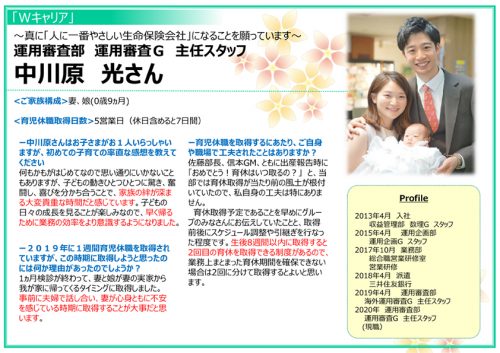Meiji Yasuda Life Insurance, which has a large number of female employees, has positioned the creation of a workplace where diverse human resources can play an active role as an important management strategy issue, and is working to create a variety of internal systems and to raise employee awareness. We interviewed Meiji Yasuda Life Insurance, which has been creating a culture that accepts men’s participation in housework and childcare as a matter of course through repeated trial and error, about specific initiatives.
Those who responded to our interview

Executive Officer and General Manager of Human Resources Dept.
Yoshikazu Asano

Manager, Diversity Promotion Office, Human Resources Dept.
Nanae Awaji
chief of staff
Yuki Omura
chief of staff
Hikaru Nakagawara
Motivation for Initiatives
While approximately 90% of Meiji Yasuda Life Insurance’s employees, including salespeople, are women, as of 2012, only 3.8% of the company’s employees were women in management positions.
In the rapidly changing social and economic environment, the Diversity Promotion Office was established within the Human Resources Department based on the top management’s recognition that the success of diverse human resources, including women, people with disabilities, and senior citizens, is essential for the company’s development. Based on the premise that in order to become a company where both men and women can play an active role, it is natural for men to participate in housework and childcare, we have been working to raise the awareness of all employees, from management to managers and general employees.
Planning and support systems to encourage “men’s participation in housework and childcare
The “Diversity & Inclusion Promotion Site” on the company’s intranet features stories of employees who have served as role models for male employees taking childcare leave. The stories, along with photos, show how they prepared for and coordinated their childcare leave, how they spent the leave period, and what changes they saw in their families and themselves as a result of taking the leave. The site also provides tips on how to spend the childcare leave period in a meaningful way.
We are producing a booklet titled “Work-Life Management Handbook for Dads. Along with interesting contents such as how to support a spouse during pregnancy, and “How to keep mom and dad smiling,” it explains the company’s childcare support system and provides a checklist of how to share household chores. We have devised a flexible way to make adjustments according to each family’s situation.
The Work-Life Management Handbook for Dads (excerpt)
In addition, we hold seminars every year to support employees returning to work after childcare leave. The purpose is to shorten career interruptions as much as possible and support a smooth return to work after childcare leave. In these seminars, we also convey the importance of both men and women taking on (sharing) housework and childcare. Senior employees also share advice based on their own experiences, such as, “You should ask your spouse to do this to balance work and childcare. We hope to change the mindset of not only the employees taking the course but also their spouses.
Efforts are also made for supervisors. The “Work-Life Management Program,” which scores subordinates’ efforts to take male childcare leave, is implemented every year and is reflected in the evaluation of their departments.
Recently, I believe this has led to a mindset change whereby department heads encourage their subordinates to take childcare leave, regardless of whether it is because they are being evaluated or not, and subordinates take it as a matter of course. In addition, it seems that female employees are more likely to work under a boss who understands men’s childcare leave.
〜Male employee (Mr. Nakagawara) who took childcare leave
I had planned to take childcare leave at the same time my wife returned from giving birth at home, so I adjusted my work schedule and took over from my boss and others beforehand. During the childcare leave, I did housework and childcare other than breastfeeding, which gave me a renewed sense of gratitude to my parents and respect for many people, including my wife.
My wife is currently pregnant with our second child. I read the “Work-Life Management Handbook for Dads” after she became pregnant with our second child. I was surprised to learn about many of the company’s systems, and the handbook helped me to learn about systems that I had not previously known were useful for childcare.
I have had my story published on the aforementioned “Diversity & Inclusion Promotion Website,” and the response from my acquaintances within the company has been great, and I am often consulted by my peers and junior staff about maternity leave. At such times, I realize that the mindset of younger employees is changing.
Since my experience with childcare leave, I have been trying to get home early, and I am more conscious of working more efficiently and productively than before.
Currently, due to the Corona disaster, I come to work once or twice a week. On telecommuting days, I have breakfast with my children and change their diapers before starting work. During my lunch break, I go for a 30-minute walk in a nearby park. My pregnant wife appreciates this very much.
Effectiveness of plans and support systems that encourage “men’s participation in housework and childcare
I am very happy to see that after 10 years, the substance of the system is beginning to emerge.
In 2010, there were zero male employees who took childcare leave. In 2012, when the Diversity Promotion Office was established, 13 men took childcare leave, and in FY2020, all 141 eligible men took childcare leave. The number of male employees taking childcare leave has been steadily increasing as a result of the culture we have fostered through our efforts.
Future Outlook
In fiscal year 2021, Meiji Yasuda Life Insurance will take a step forward from the conventional “work-life balance” that aims to balance “work” and “life” to “work-life management” that aims to improve productivity through a work style that emphasizes a virtuous cycle between “work” and “life” and an organization-wide effort with support from superiors. The company has changed to a new phase of “work-life management. The concept of balancing and allocating time between work and private life is based on the idea that “public” and “private” are separate and must be balanced. In “work-life management,” both the company and its employees actively manage their work and private time, and manage what issues exist not only at work but also at home. We will not only promote childcare leave, but also enhance the quality of the leave by ensuring that it is accompanied by substance. Even if the form of leave is completed, if it is not accompanied by substance, employee engagement will not increase. This is the purpose of the phase change from work-life balance to work-life management.
How to link diversity promotion efforts, including men’s participation in housework and childcare, to corporate competitiveness and productivity is a major theme for the future. Until now, men have played a central role in determining company policy, but by actively promoting women, including regional-type employees, to management positions, I believe that women’s opinions will also be addressed in management, which will bring us closer to our customers and lead to higher productivity. By further promoting diversity and inclusion, we aim to raise the quality of life and productivity of our employees.
Click here to see Meiji Yasuda Life Insurance’s diversity and inclusion initiatives.
https://www.meijiyasuda.co.jp/profile/csr/employee/management.html

